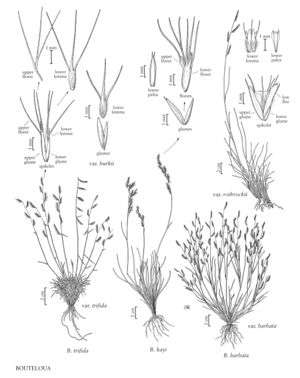familyPoaceae
subfamilyPoaceae subfam. Chloridoideae
genusBouteloua
subgenusBouteloua subg. Chondrosum
speciesBouteloua trifida
Difference between revisions of "Bouteloua trifida var. trifida"
Treatment appears in FNA Volume 25. Treatment on page 264.
imported>Volume Importer |
imported>Volume Importer |
||
| Line 38: | Line 38: | ||
|publication year= | |publication year= | ||
|special status= | |special status= | ||
| − | |source xml=https:// | + | |source xml=https://bitbucket.org/aafc-mbb/fna-data-curation/src/2e0870ddd59836b60bcf96646a41e87ea5a5943a/coarse_grained_fna_xml/V25/V25_890.xml |
|subfamily=Poaceae subfam. Chloridoideae | |subfamily=Poaceae subfam. Chloridoideae | ||
|tribe=Poaceae tribe Cynodonteae | |tribe=Poaceae tribe Cynodonteae | ||
Revision as of 21:05, 5 November 2020
Panicle branches appressed to ascending, occasionally divergent. Lower glumes 2.2-3.4 mm, midveins excurrent for 0.1-0.6 mm; upper glumes 2.7-4 mm, midveins excurrent for 0.2-1 mm; lower lemmas glabrous or sparsely appressed pubescent along both sides of the veins, awns (3.2)4-6.6 mm; anthers 0.3-0.4 mm. Caryopses 1.3-1.5 mm long, 0.4-0.5 mm wide, grooved adaxially. 2n = unknown.
Distribution
Utah, Calif., Ariz., Nev., N.Mex., Tex.
Discussion
Bouteloua trifida var. trifida grows in dry plains and rocky slopes, mostly at 300-1500 m, from southern California, Nevada, and Utah to Texas and Mexico.
Selected References
None.
Lower Taxa
None.
... more about "Bouteloua trifida var. trifida"
